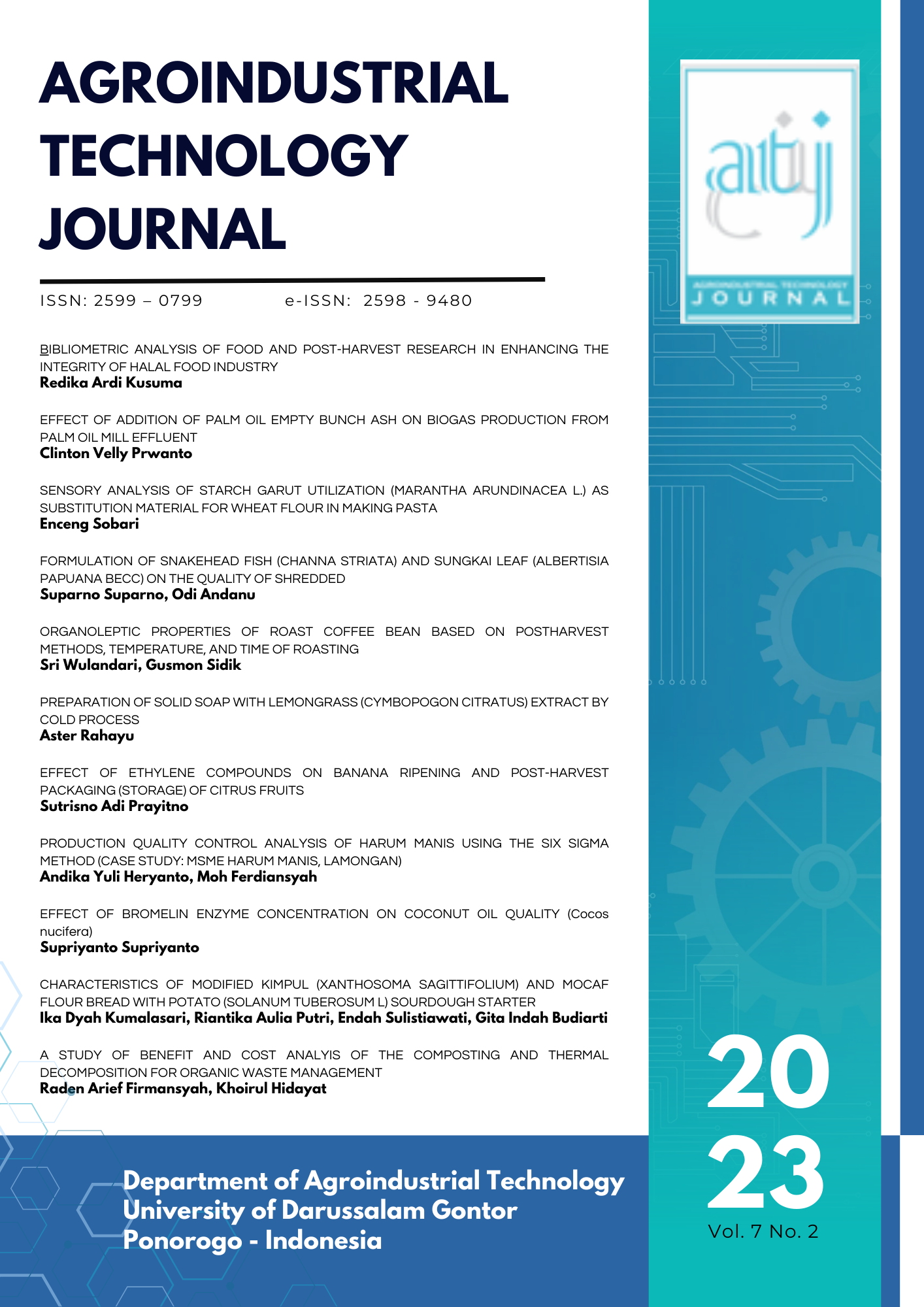PRODUCTION QUALITY CONTROL ANALYSIS OF HARUM MANIS USING THE SIX SIGMA METHOD (CASE STUDY: MSME HARUM MANIS, LAMONGAN)
DOI:
https://doi.org/10.21111/atj.v7i2.9268Keywords:
Harum Manis, Pengendalian Kualitas, Six- sigma.Abstract
The Harum Manis was a popular traditional food in the 1990s made from sugar, flour, and food coloring. MSME Harum Manis is an MSME that produces harum manis snacks that have been in production since 2012. The author's observations found that the company had problems in its production process, namely, defective products. Types of harum manis product defects are stable fracture, rough fracture, and soft looseness. This research aims to identify the factors that cause product defects, calculate the sigma value in the production harum manis products, and provide suggestions for improving the quality control of harum manis production. The research uses the six sigma method with the concept of DMAIC (define, measure. analyze, improve, and control). The sample used in each data collection is 30 kg. The defect factors for the harum manis product are the slow gulali withdrawal process, the employees being less skilled, the lack of employee training, the addition of flour needs to be more stable, and the production room is now open. The sigma level obtained from MSME Harum Manis in October was 3.4, while in November, a sigma value of 3.28 was obtained. Proposed improvements include conducting training for new and old workers on an ongoing basis, making standard operating procedures (SOP) for workers, making SOP regarding the production process in detail, and closing the production room during production.References
Anthony, M.B (2016). Analisis Penyebab Kerusakan Hot Rooler Table dengan Menggunakan Metode Failure Mode And Effect Analysis (FMEA). Jurnal INTECH, 4 (1), 1-8. https://doi.org/10.30656/intech.v4i1.851
Arsyad, A. G., Ferdinant, P. F., & Ekawati, R. (2017). Analisis Peta Kendali P Yang Distandarisasi Dalam Proses Produksi Regulator Set Fujiyama (Studi Kasus : PT. XYZ). Jurnal Teknik Industri, 5(1), 86-92.
Badriyah, N., Chusnul, K.U., & Tahjudin, M. (2019). Pengembangan Jajanan Tradisional Rambut Nenek Melalui Pendekatan One Village One Product di Desa Kesambi Kecamatan Pucuk Kabupaten Lamongan. Martabe : Jurnal Pengabdian Masyarakat. 2(2), 124-129.
Darmawan, A., Bahri, S., & Putra, A. T. B (2020). Six Sigma Implementation in Quality Evaluation of Raw Material: A Case Study. IOP Conf. Series: Materials Science and Engineering 875. The 3rd EPI International Conference on Science and Engineering 2019 (EICSE 2019). https://iopscience.iop.org/article/10.1088/1757-899X/875/1/012065/meta
Hartoyo, A., Yudhistira., Y, Chandra, A., & Chie, H. W. (2013). Penerapan Metode Dmaic Dalam Peningkatan Acceptance Rate Untuk Ukuran Panjang Produk Bushing. Comtech: Computer, Mathematics And Engineering Applications, 4(1), 381-393. https://doi.org/10.21512/comtech.v4i1.2761
Fajaranie, A. S., & Khairi., A. N. (2022). Pengamatan Cacat Kemasan Pada Produk Mie Kering Menggunakan Peta Kendali dan Diagram Fishbone Di Perusahaan Produsen Mie Kering Semarang, Jawa Tengah. Jurnal Pengolahan Pangan, 7(1), 7-13. https://doi.org/10.31970/pangan.v7i1.69
Gaspersz, V. (2002). Metode AnalIsis Untuk Peningkatan Kualitas. PT Gramedia Pustaka Utama: Jakarta.
Kusnawati, A., & Fitriyeni, L. (2017). Pengendalian Kualitas Proses Pengemasan Gula Dengan Pendekatan Six Sigma. Jurnal Sistem dan Manajemen Industri. 1(1), 43-48. https://doi.org/10.30656/jsmi.v1i1.173
Kurniawan. A. S., & Adinna, F. (2018). Analisis Pengendalian Kualitas Proses Produksi Kue Lapis Kukus Surabaya Berdasarkan Metode Six Sigma. Jurnal statistika, 18(1), 21-29. https://doi.org/10.29313/jstat.v18i1.3873
Luo, T., Chao Wu., & Duan, L. (2018). Fishbone diagram and risk matrix analysis method and its application in safety assessment of natural gas spherical tank. Journal of Cleaner Production, 174 (2018), 296-304. https://doi.org/10.1016/j.jclepro.2017.10.334
Nurizal, R. R., Muhardi., & Adwiyah, R. (2021). Analisis Desian Letak Fasilitas Produksi Dengan Menggunakan Metode Load Distence dan Material Handling Cost Untuk Meminimumkan Biaya Produksi Pada CV. X. Bandung Conference Series : Business and Management, 1(1), 7-13. https://doi.org/10.29313/bcsbm.v1i1.99
Ouyang, L., Che, Y., Yan, L.,& Park, C. (2022). Multiple perspectives on analyzing risk factors in FMEA. Computers in Industry Journal. 141 (2022), 103712. https://doi.org/10.1016/j.compind.2022.103712
Pujangga, G. A., & Kholil, M. (2015). Penerapanmetodesixsigmasebagai Upaya Pengendali Kualitas Produk Dengan Menggunakan Konsep DMAIC. Ratih (Jurnal Rekayasa Teknologi Industri Hijau), 1(2), 1-10.
Ratnadi & Suprianto, E. (2016). Pengendalian Kualitas Produksi Menggunakan Alat Bantu Statistik (Seven tools) dalam Upaya Menekan Tingkat Kerusakan Produk. Jurnal INDEPT. 6(2), 10-18.
Sucipto, S., Astuti, R., dan Megawati, A. (2018). Analisis Kualitas Pengemasan Vakum Ikan Beku dengan Metode Six Sigma (Studi kasus di PT X, Pasuruan Jawa Timur). Jurnal AGROINTEK, 12(2), 99-107.
Wilujeng, F. R., dan Wijaya, T. (2019). Penerapan Metode DMAIC untuk PengendalianKualitas pada UKM Tempe Semanan. Prosiding Seminar Intelektual Muda. 266-271. Inovasi Ilmu Pengetahuan, Teknologi Dan Seni Dalam Perencanaan dan Perancangan Lingkungan Terbangun. Universitas Trisakti. 11 April 2019. https://doi.org/10.25105/psia.v1i1.5959
Yemima, O., Nohe, D. A., Nasution, Y. N. (2014). Penerapan Peta Kendali Demerit dan Diagram Pareto Pada Pengontrolan Kualitas Produksi (Studi Kasus: Produksi Botol Sosro di PT. X Surabaya). Jurnal EKSPONENSIA. (2), 197-201.
Downloads
Submitted
Accepted
Published
How to Cite
Issue
Section
License
Copyright (c) 2023 Agroindustrial Technology Journal

This work is licensed under a Creative Commons Attribution-NonCommercial-ShareAlike 4.0 International License.
The author whose published manuscript approved the following provisions:
1. The right of publication of all material published in the journal / published in the Agroindustrial Technology Journal is held by the editorial board with the knowledge of the author (moral rights remain the author of the script).
2. The formal legal provisions for access to digital articles of this electronic journal are subject to the terms of the Creative Commons Attribution-NonCommercial-ShareAlike 4.0 International License (CC BY-NC-SA 4.0), which means that Agroindustrial Technology Journal reserves the right to save, transmit media or format, Database), maintain, and publish articles without requesting permission from the Author as long as it keeps the Author's name as the owner of Copyright.
3. Printed and electronically published manuscripts are open access for educational, research and library purposes. In addition to these objectives, the editorial board shall not be liable for violations of copyright law.



